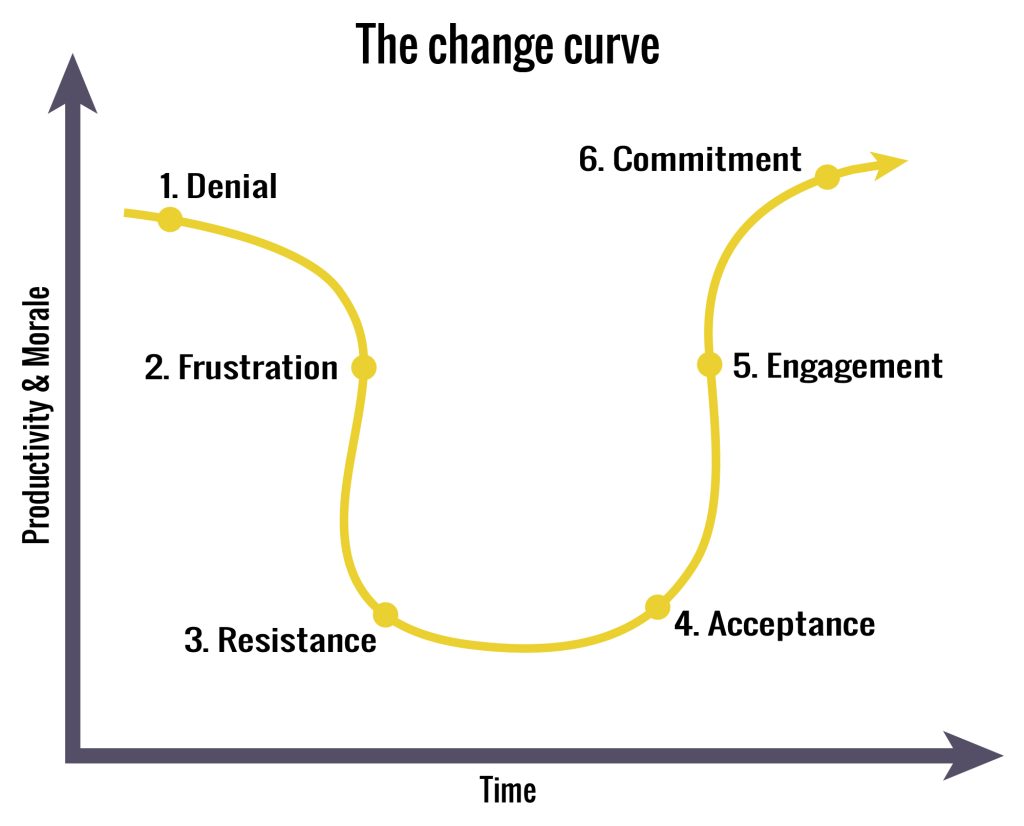

“A change is gonna come.” Our guide to effective communication for organisational change
“A change is gonna come.” Our guide to effective communication for organisational change
For a business to succeed and stay relevant in today’s competitive marketplace it needs to evolve. It may need to take advantage of new technologies, expand, rebrand, make structural improvements or adjust to new circumstances. Who among us hasn’t had to evolve in response to Brexit or Covid?
Let’s be honest, though. What we’re really talking about is change, and CHANGE is a big, scary word. Particularly for your employees. Change means disrupting, adapting, and doing things differently. And while we all know that a change can do you good, it’s not always painless.
To carry out successful, meaningful change in an organisation – whether cultural, behavioural, transformational, strategical, operational or technological – you need employee buy-in. And to get that, you need to communicate.
The role of employee comms
When facing major change, it’s likely that your employees will follow the well-documented change curve that starts with denial and resistance. Your challenge is to move them to acceptance and commitment as quickly and painlessly as possible. A successful communication campaign can dramatically reduce the trough, and lessen the natural anxiety.


To fully embrace change, employees need to understand its purpose and see the benefits. Your Internal comms are the key – they can help build understanding, guide employees through the change, inform and encourage them, and invite feedback and discussion. When communicated well, change can be seen as an opportunity – even an exciting one.
What does an effective communication campaign look like?
An effective campaign will give your employees the motivation and the tools to implement organisational change successfully, and to build a more resilient business for the future. Here are our top tips.
1. Give them a vision
Be clear and open: what is the change, what is the end goal, and how will it benefit the business and your people? Employees need to know where are you heading and what’s in it for them, so tell them a story. It’s easier to head towards a new destination if you can picture yourself there and imagine the rewards. Ideally, this message should come direct from the top.
2. Make them part of it
In the 1980s, Scandinavian Airlines was losing business and in trouble. They set themselves a goal of increasing revenue by $25million and gave every employee a handbook entitled: “Let’s Get in There and Fight”. Its message was: ” We have to fight competitors who are more efficient than we are. And who are at least as good as we are in figuring out the best deals. We can do it. But only if we are prepared to fight. Side by side. We are all in this together.” The handbook put their employees at the heart of the story, making them heroes with a clear role to play. The revenue increase that year was $80million.
The best campaigns inspire individuals to become active participants in and agents of change. Make your people feel like the heroes of their own future – show them how they can each make a difference – not just leaders but HR, IT and middle managers – anyone who has influence across your organisation. Human connections are what will drive the most effective change.
3. Give them the right tools
If you were bringing a new product to market, you’d make a detailed marketing plan and invest time and resource on its launch. Internal change should be no different. By investing resources in the change, you also give a clear signal of its importance. Make sure you allocate people with the right skills and experience to help deliver the change and give everyone the tools, resources and training they need to implement it. A step-by-step plan of what will happen when is great for managing expectations.
4. Listen – share successes and feedback
Creating two-way conversations with your employees is vital if you want to keep them engaged. Give them a chance to ask questions and raise concerns, face to face if you can, though anonymous surveys can be helpful too. Give regular time to discuss progress, add it to the agenda of every meeting and include progress reports in newsletters. Make sure you celebrate successes but be open about delays or problems.
After the financial crash in 2008, Starbucks was forced to shut down operations at almost 1,000 locations and lost 28% of its earnings over the next two years. At the same time, they launched “My Starbucks Idea”, asking staff and consumers to share their ideas of how to improve their service and offering. Over 90,000 ideas were shared on social media and Starbucks listened. They implemented over 100 suggestions that turned its fortunes around and also created a community of baristas and coffee lovers that continues to this day.
5. Keep telling the story
“Again, again!” There are some stories that you never get tired of, and some that you don’t get the full meaning of first-time round. Communicating change isn’t a one-hit wonder; you need to keep telling the story. Keep sharing your vision for a better future to inspire your protagonists and point them in the right direction. That way you’ll keep them engaged and motivated, and more willing to make the change with you.
Use all available channels
Make the most of your full range of communication channels to engage your team and keep them motivated. They’ll all have a part to play.
All-hands meetings allow you to reach out to your entire organisation to share the vision, while town halls are great for inviting questions and feedback. If you can organise individual team meetings too, so much the better.
Emails and your intranet are ideal ways to reinforce and embed key messages and timeframes, while regular short videos allow you to keep momentum going and keep your teams focused.
Use surveys to measure sentiment, and social media as a valuable way to keep the conversation going and gauge reactions to progress.
Need a helping hand?
At Lucent we’re experts at helping companies to deepen their employee engagement and communicate for successful organisational change. If you’re in the process of planning a change that will affect your employees, why not talk to us first. A change is gonna come, but how it comes can make all the difference.
Recent posts
-
23rd May 2024
From equality to equity – the changing face of EDI -
22nd June 2023
Why go looking for your inner child? -
8th June 2023
Why employer-supported volunteering does everyone good
